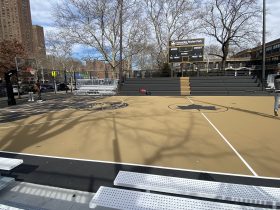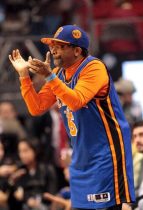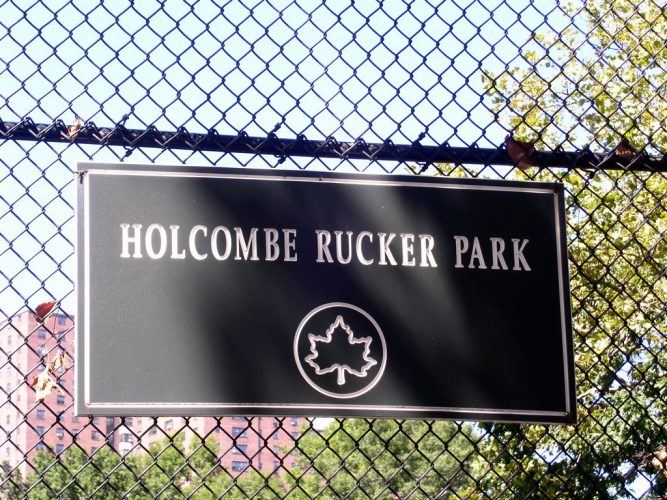When talking about the history of basketball in New York there are two distinct eras that each play an important role in not only the evolution of the sport, but the city as a whole. Those two eras being the era of professional basketball and the era of streetball. The best place to start is where many basketball legends first started, that being streetball courts throughout the city. Streetball in New York can’t be traced back to any specific court or area, rather small communities sprung up in several courts around the city. Some of those courts have become household names amongst basketball fans across the country. Some of those courts are The Cage, which gained it’s name from the tight chain link fencing surrounding the court, Dyckman park and the world-famous Rucker Park[1]. Streetball courts like Rucker Park have played an important role in many people’s lives. Rucker Park is stationed on the edge of the Harlem River between the Bronx, Washington Heights and Harlem[2]. When basketball fans think of Rucker Park, they tend to think of a packed court with fans all around. However, on an average day you are likely to find an un-assuming court with a children’s park right next door. The reason why this small court and public park means so much to people is because of the history that has been made on that court. Many future NBA legends, as well as many players known much more for their streetball careers have gotten their start or have tested their own skills at Rucker Park against the best that the Bronx and Harlem had to offer. Some of those legends, Wilt Chamberlin, Kareem Abdul-Jabbar and Julius “Dr. J” Erving, got the chance to face off against streetball Icons like Richard “Pee Wee” Kirkland, Herman “Helicopter” Knowlings and Earl “The Goat” Manigault[3]. Many of the stories from the early era of streetball need to be taken with a grain of salt. For example, it is claimed that six foot two “Jumpin’ Jackie” Jackson could grab quarters off of the top of a backboard. Events like this, which sound impossible even by today’s standards, seemed to have happen often. While some stories are of super human athleticism, others paint the scene as a lavish lifestyle where players got paid to do what they loved. One story that stands out is when Richard “Pee Wee” Herman would show up to Rucker Park and double park his rolls Royce before laying down the law[4]. One of the biggest draws to Rucker Park was the chance for people to prove themselves. Many people saw streetball as an outlet to escape the challenges of day-to-day life. The rise of streetball gave more people that chance to prove themselves and opened up more chances for people to obtain education. For many people, basketball was their only way to secure an education and that chance alone was enough for people. While all streetball is basketball, not all basketball is streetball. Since the early 90’s, streetball has begun to take on a life of its own. Through several different media sources like videogames such as NBA Street, several magazines and books as well as several up-and-coming clothing brands, the popularity of streetball had hit an all time high. Brands like AND1 helped further the reach of streetball by creating their AND1 Mixtapes. The AND1 Mixtapes were fifteen-to-twenty-minute videos showing only what the people wanted to see. The mixtapes consisted of only the nastiest crossovers, ankle breakers and dunks that could be found by amateur players across the nation[5]. The increased exposure allowed the most famous streetball tournament, the EBC (Entertainers Basketball Classic) to get more eyes than ever. Tournaments like the EBC have brought national attention to this small little park in the heart of New York City[6]. This national exposure has come to a head multiple times, like when Kobe Bryant came and played in 2002[7][8] or when Kevin Durant came and dropped 66 points in a game in 2011 during the NBA lockout[9]. This is one of the most important aspects of Rucker Park. An average person can step up and try to prove themselves against their heroes. As you stand on that court, no matter the time of day or year, you can feel the energy of those past legends. You can picture Earl “The Goat” Manigault going to war against Kareem Abdul-Jabar. You can feel the crowds of people chanting for Kobe or Durant. Even on a cold day, in the middle of Feburary, you’re still likely to find one or two people shooting around. Between the history that the court holds and the importance that it has to the general area, Rucker Park is not only an iconic New York City location, but one of the most important basketball locations in the entire world.

An image from the bleachers sitting courtside in Holcombe Rucker Park[10]
From one iconic basketball location to the next, the next and final stop on the tour is Madison Square Garden. Madison Square Garden (MSG) is one of, if not the most important arenas in all of the world. However, the MSG that many of us know and love today is not the original version of this beloved arena. The origins of MSG dates all the way back to the year 1879 when it was reclaimed by the Vanderbilt family after being ran by P.T. Barnum as a circus venue. After being ran as an open-air arena for many years, it was sold to Andrew Carnegie and J.P. Morgan and the two men built a new venue which was fully enclosed. This building stood for several years until it was demolished to make way for a new headquarters for the New York Life Insurance Company. The third iteration of MSG stood for 43 years and saw many legendary events like New York Rangers Stanley Cups, world boxing titles and a special birthday song from Marylyn Monroe to President Kennedy. However, in 1968, it was time for an upgrade. On Feburary 11th, 1968, the newest and current version of MSG was built[11]. Many legendary events have happened at this version of MSG, such as multiple concerts raising money after tragedies, NHL championships and the fight of the century between Muhammad Ali and Joe Frazier[12]. However, one of the reasons MSG is know best is because they’re the “Mecca of Basketball”. The main tenant of MSG is the New York Knicks. In a city that is torn into two with most sports, the New York Knicks were a cause that almost all of New York could get behind. When talking about sports with people from New York you would always have to ask a few questions. Do you cheer for the Mets or the Yankees? Do you support the Giants or the Jets? Are you a Rangers fan or an Islanders fan? However when it came to basketball, up until 2012 when the Nets moved from New Jersey to Brooklyn, there only was option. Unlike baseball and hockey, where when the two New York teams played half the team was angry, the Knicks were a team that the entire city could get behind. When the Knicks were winning, New York was winning. New York had a lot of trouble winning in their early days. In 1950 the Knicks made it to three straight NBA finals and sadly lost all three of them. Luckily, everything came together for the Knicks in 1970 when they won their first NBA title. After six hard fought games against the Los Angeles Lakers, the Knicks were able to beat Wilt Chamberlin and Jerry West to claim their first NBA championship[13]. Wilt Chamberlin, known for playing and entertaining people at Rucker Park, was the final stepping stone for the Knicks to get over the hump. Three years later, the Knicks were able to do it again and hit the peak and won their second NBA title in three years. Sadly, the Knicks have not been able to replicate that success again since then. Since the inception of the Knicks, New York gained a reputation for being a very tough and hard nose city. New Yorkers don’t take anything from anyone. In the late 90’s the Knicks really epitomized this hard nose mindset. This mindset ended up presenting itself on the court in the form of many fights and hard fouls. One fight was documented in the New York Amsterdam News early in 2007. While the paper details the fight in a very negative light, many New Yorkers admired the passion that the Knicks played with[14]. The Knicks can be seen as a microcosm of the people of New York. Much like the city, the Knicks found their grove in the early 70’s then hit a tailspin. The Knicks found there groove again in the late 90’s and up to 2000. New York was struck with disaster in 2001 thanks to the terrorists attacks on September 11th. After the event there were few places where people could turn. Sports was one of those places. The Yankees making it to the world series in 2001 and the homerun by Mike Piazza were two of the biggest sports moments of the year that unified the city. However, no matter the circumstances, some fans were angry that the other team was winning. The knicks playing hardnosed basketball reminded the city that no matter how bad it gets, that the New York spirit and resolve never quits. Apart from being a microcosm of the New York people as a whole, the team also represents individual under represented communities. The best example of this is with New York Knicks legend Jeremy Lin. Lin was not a star player by any stretch of the imagination. However, during a small stretch of games during the 2012 season, Jeremy Lin took over the sports world. Jeremy Lin came off the bench during a game against the New Jersey Nets and scored 25 points in a Knicks win. This was just the start. For the next few games Jeremy Lin took over and played better than he ever had before. This run of games, which has lovingly been titled “Linsanity” came to a head on valentine’s day when, with less than a second left, Jeremy Lin hit a game winning three-point shot. The world was infatuated with Lin and there was no community this was more important to than the Asian community in New York and the country as a whole. These events helped to quell many of the Asian American stereotypes that many New Yorkers had to deal with[15]. New York was and always will be a melting pot and the New York Knicks have always portrayed that idea. The New York Knicks have always been a microcosm of the city of New York. The Knicks, as well as MSG, have played a large role in the history of New York and when looking at the history of basketball within the New York, you can not leave out the Knicks.

[1] “Streetball Shrines: NYC’s Best Outdoor b-Ball Courts.” Time Out New York, https://www.timeout.com/newyork/things-to-do/streetball-shrines-nycs-best-outdoor-b-ball-courts. Accessed 2 Apr. 2022.
[2] A History of New York City Basketball. https://nycbasketball.nba.com/index.html. Accessed 19 Feb. 2022.
[3] “New York City Streetball.” New York City Streetball, http://nycstreetball.weebly.com/. Accessed 19 Feb. 2022.
[4] A History of Rucker Park As Told By Fat Joe and God Shammgod.” Complex.Com, https://www.complex.com/sports/history-of-rucker-park-true-basketball-mecca. Accessed 19 Feb. 2022.
[5] Thomas P Oates. “Selling Streetball: Racialized Space, Commercialized Spectacle, and Playground Basketball.” Critical Studies in Media Communication, vol. 34, no. 1, Mar. 2017, pp. 94–100. EBSCOhost, https://doi.org/10.1080/15295036.2016.1266681.
[6] —. “‘Where I’m From’: Jay-Z’s ‘Hip Hop Cosmopolitanism,’ Basketball, and the Neoliberal Politics of Urban Space”.” Sociology of Sport Journal, vol. 37, no. 3, Sept. 2020, pp. 183–91. EBSCOhost, https://doi.org/10.1123/ssj.2019-0045.
[7] LakersDynasty42. Kobe Bryant Playing at Rucker Park (2002). 2011. YouTube, https://www.youtube.com/watch?v=zxIN_b-vhNQ.
[8] “The Magical Day Kobe Bryant Became Lord of the Rings at Rucker Park.” ESPN.Com, 12 Aug. 2021, https://www.espn.com/nba/story/_/id/31999002/the-magical-day-kobe-bryant-became-lord-rings-rucker-park.
[9] Fresh Focus Sports. Kevin Durant FULL Highlight at Rucker Park (2011) Lockout Summer! 2020. YouTube, https://www.youtube.com/watch?v=ESkDIANxh2A.
[10] Photo of Holcombe Rucker Park by Charlie Marcello, February 20th, 2022
[11] Jeremy Albelda. “The History of Madison Square Garden.” The World or Bust, 18 Nov. 2014, https://www.theworldorbust.com/the-history-of-madison-square-garden/.
[12] “Madison Square Garden – Defining Moments.” Hotels4Teams, https://www.hotels4teams.com/travel-guide/madison-square-garden-defining-moments/. Accessed 3 Apr. 2022.
[13] LEONARD KOPPETT. “Knick Championship Culminates 24 Frustrating Years: Dream Is Realized Through Teamwork, Dedication, Skill 24-YEAR DROUGHT ENDS FOR KNICKS.” New York Times, 1970, p. 175.
[14] Richard Carter. “The Brawling New York Knicks: From Bad to Worse to Ugly.” New York Amsterdam News, vol. 98, no. 2, 4 Jan. 2007, pp. 11–31.
[15] Hua Hsu. “Everyone Else’s Jeremy Lin.” Amerasia Journal, vol. 38, no. 3, Dec. 2012, pp. 126–29.
[16] New York Knicks at Miami Heat, American Airlines Arena, Miami, Fl.: New York Knicks Fan Spike Lee Cheers during 1st Half Action against The Miami Heat at the American Airlines Arena, in Miami Florida, December 28,2010. The Miami Heat Beat the New York Knicks 106-98.. UPI/Susan Knowles… Dec. 2010. EBSCOhost, https://search.ebscohost.com/login.aspx?direct=true&AuthType=shib&db=imh&AN=imh698943&site=ehost-live&custid=s8475574.
